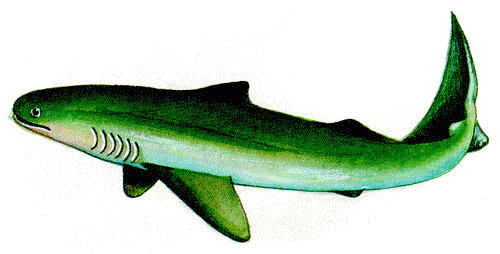The sharks we are familiar with are cartilaginous fishes.
Nearly all cartilaginous fishes are aquarium/52-marine-animals.html">marine animals. Throughout their life history (the entire process of a living organism from beginning to end), their skeletons are always cartilaginous, with the hard parts usually consisting only of teeth and spines, from which most cartilaginous fish fossils are known. Occasionally, fully calcified skulls, jaws, vertebrae, etc. are preserved as fossils.

rip shark
The most primitive cartilaginous fish is represented by the rip shark, and their most complete fossils were found in the Late Devonian black shale of Groveland on the southern shore of Lake Erie in the United States. Interestingly, the mouths of modern sharks usually have transverse slits, while the mouths of rip sharks have straight slits. The maxilla of the rip shark is connected to the skull by two joints, one is the postorbital joint, just behind the eye socket, and the other is located at the back of the skull, where the skull is connected to the connecting rod on the back of the lingual and mandibular bone. This type of connection between the maxilla and the skull is called a double connection, and it is a fairly primitive connection. The teeth of the rip shark have a high cusp in the middle and a low cusp on each side. Many ancient cartilaginous fish have such a structure.
The structure of the rip shark represents the primitive model among cartilaginous fishes in many aspects. It can be considered to be close to the base point of the main line of the cartilaginous fish evolutionary system. Later sharks may have developed from here along their respective evolutionary directions. , they include the order Pristosaurus, the order Sharks, the order Dimetrodon, the order Hexabranchia, the order Porphyra and the order Rays. These orders form the most prosperous group of cartilaginous fishes: Elasmobranchia. Another group of cartilaginous fishes with few species that live in the deep sea forms a separate group of cartilaginous fishes: Holocephala due to its unique self-joining skull-jaw bone connection method. The chimaera is a representative of the subclass Holocephalis, and its evolutionary history can be traced back to the early Jurassic.
An extremely large number of tooth plates suitable for grinding were also found in the strata of the late Paleozoic Era. They are collectively called bradylodonts, and their genetic relationship has not yet been determined.
The tooth fossils of the rip shark have been found in the Carboniferous strata of Zhanyi, Yunnan, my country; the stinging fossils of the shark have been found in the Late Triassic strata of Kunming.
animal tags: bradyodon
We created this article in conjunction with AI technology, then made sure it was fact-checked and edited by a Animals Top editor.